Abstract
OBJECTIVES: This study examined the effectiveness of a hospital program to promote exclusive breast-feeding in Santos, Brazil. METHODS: In a prospective design, women who delivered at a hospital with an active breast-feeding promotion program (n = 236) were compared with women who delivered at a nearby control hospital (n = 206). RESULTS: The two groups had similar demographic characteristics and previous breast-feeding histories. Exposure to breast-feeding activities, assessed by maternal recall prior to discharge, was universally high at the program hospital and universally low at the control hospital. Multivariate survival analysis showed that exclusive breast-feeding lasted 53 days longer among women who delivered at the program hospital. CONCLUSIONS: Hospital-based breast-feeding promotion programs may be effective in extending the duration of exclusive breast-feeding.
Full text
PDF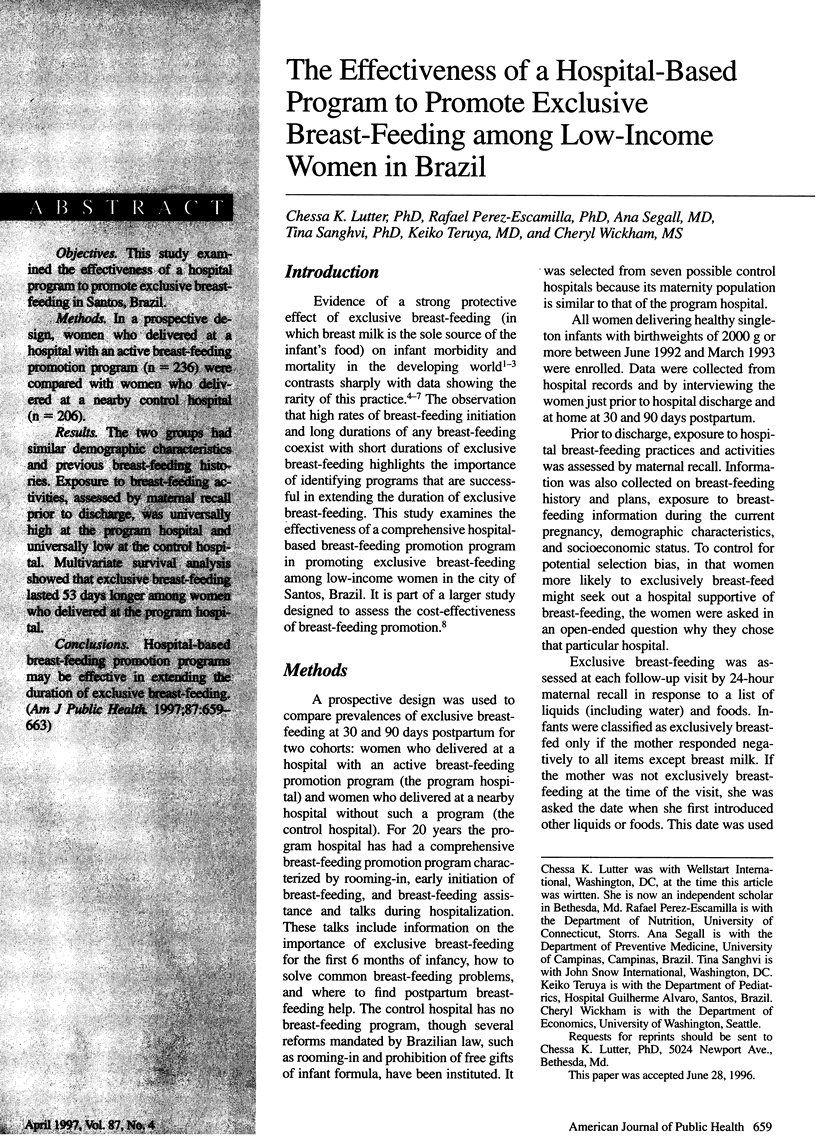
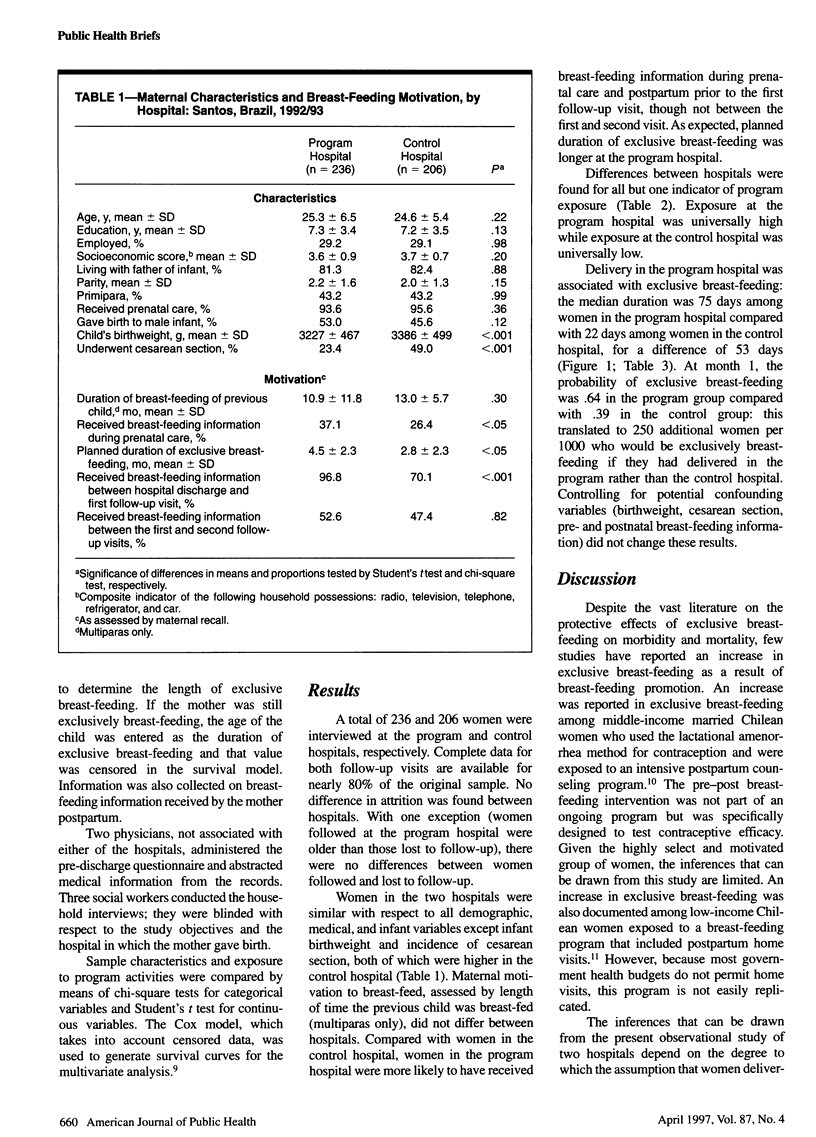
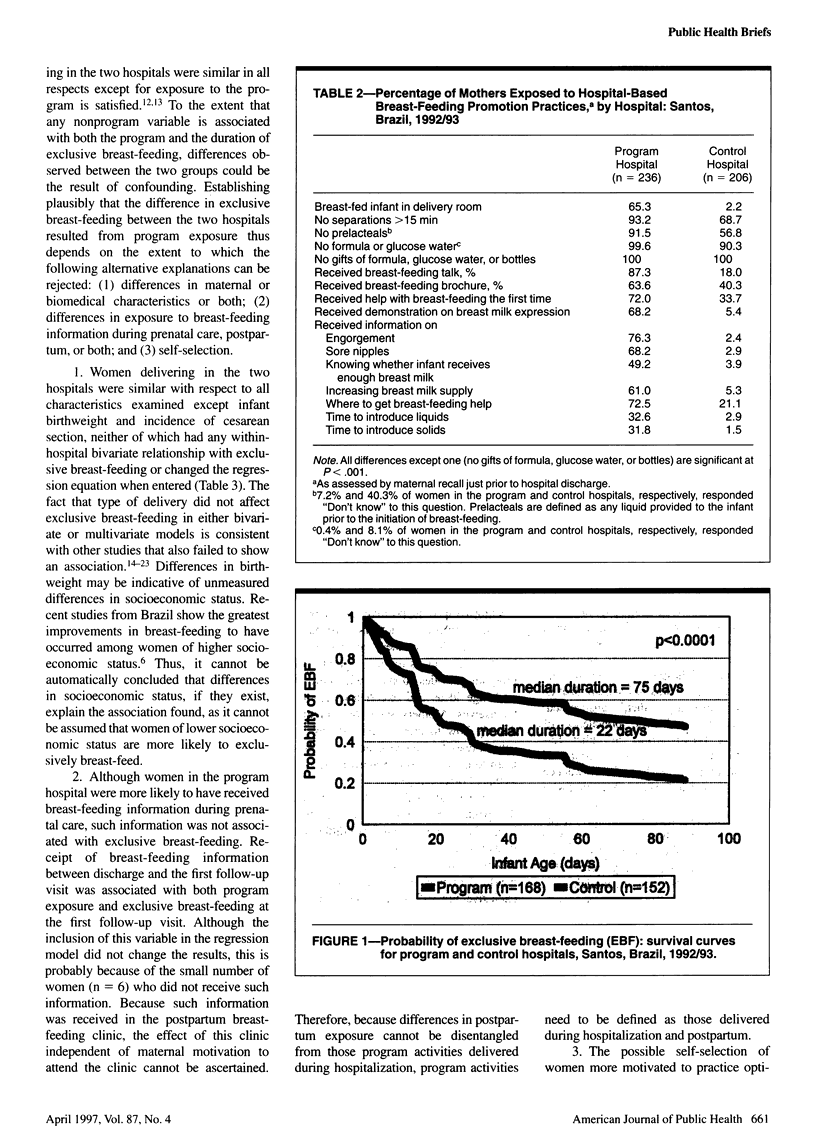
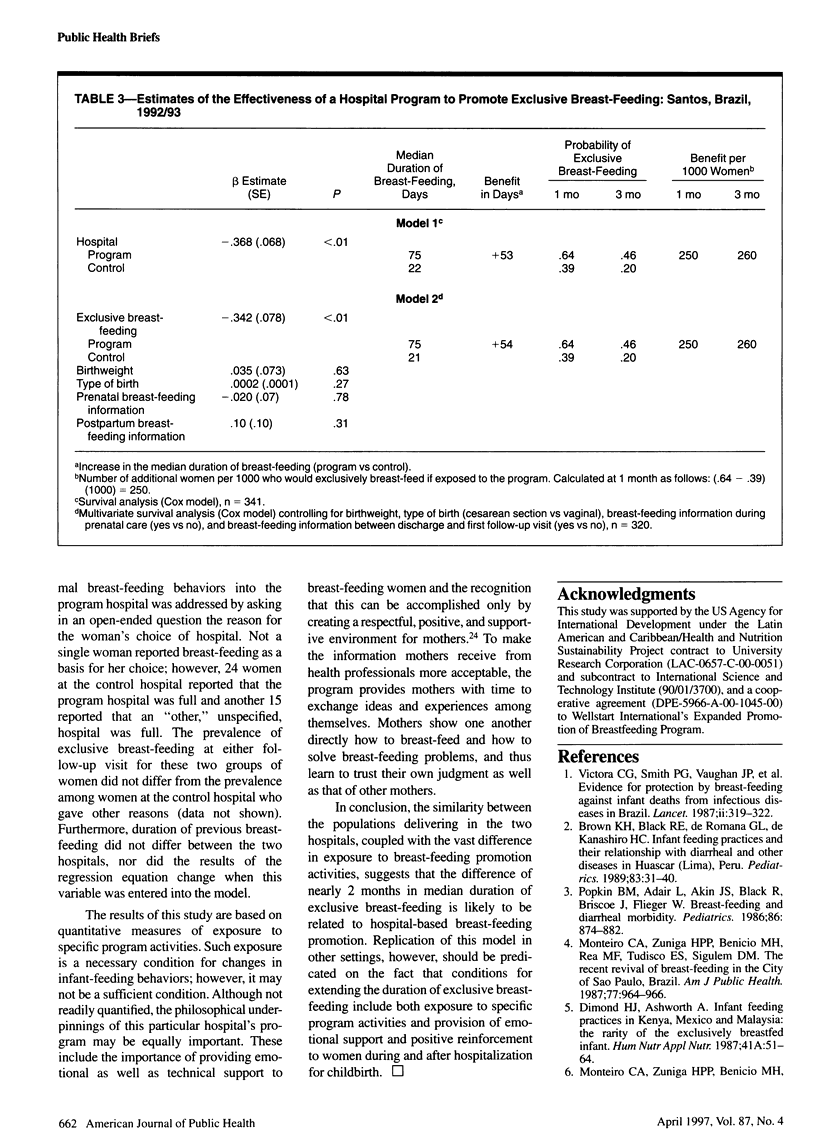
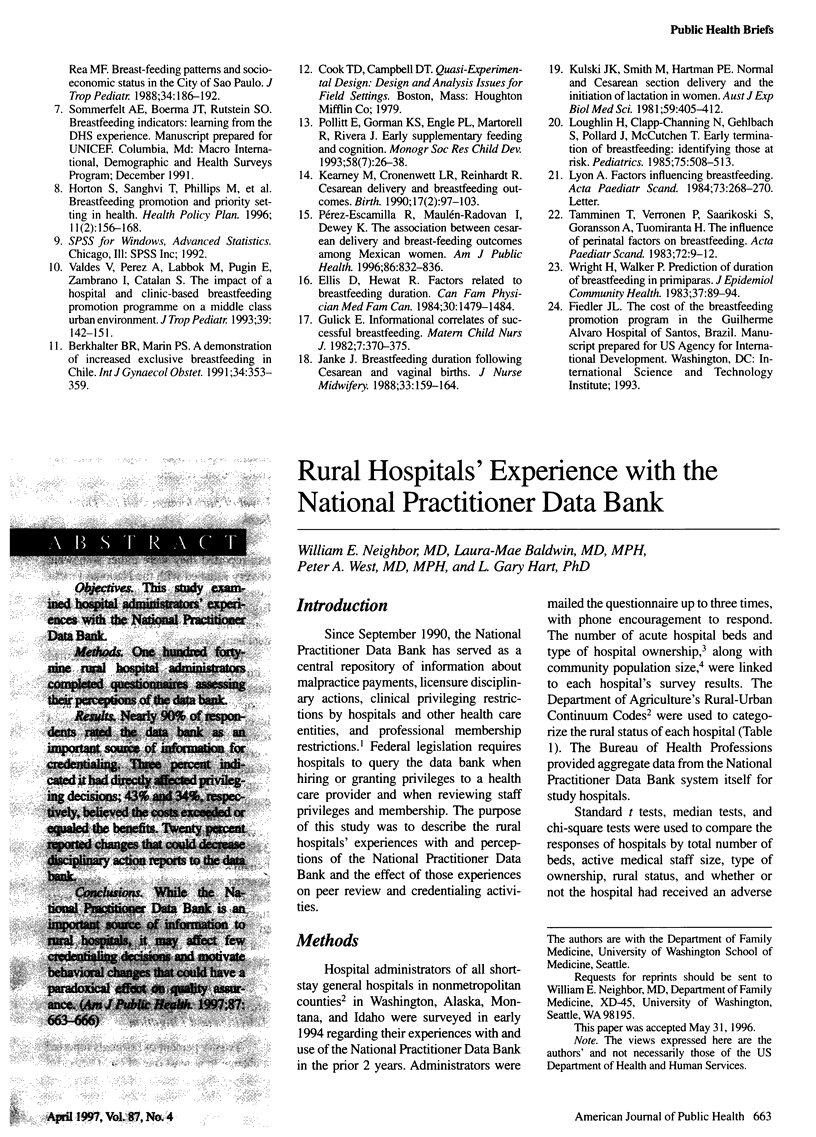
Selected References
These references are in PubMed. This may not be the complete list of references from this article.
- Brown K. H., Black R. E., Lopez de Romaña G., Creed de Kanashiro H. Infant-feeding practices and their relationship with diarrheal and other diseases in Huascar (Lima), Peru. Pediatrics. 1989 Jan;83(1):31–40. [PubMed] [Google Scholar]
- Burkhalter B. R., Marin P. S. A demonstration of increased exclusive breastfeeding in Chile. Int J Gynaecol Obstet. 1991 Apr;34(4):353–359. doi: 10.1016/0020-7292(91)90604-4. [DOI] [PubMed] [Google Scholar]
- Dimond H. J., Ashworth A. Infant feeding practices in Kenya, Mexico and Malaysia. The rarity of the exclusively breast-fed infant. Hum Nutr Appl Nutr. 1987 Feb;41(1):51–64. [PubMed] [Google Scholar]
- Gulick E. E. Informational correlates of successful breast-feeding. MCN Am J Matern Child Nurs. 1982 Nov-Dec;7(6):370–375. [PubMed] [Google Scholar]
- Horton S., Sanghvi T., Phillips M., Fiedler J., Perez-Escamilla R., Lutter C., Rivera A., Segall-Correa A. M. Breastfeeding promotion and priority setting in health. Health Policy Plan. 1996 Jun;11(2):156–168. doi: 10.1093/heapol/11.2.156. [DOI] [PubMed] [Google Scholar]
- Janke J. R. Breastfeeding duration following cesarean and vaginal births. J Nurse Midwifery. 1988 Jul-Aug;33(4):159–164. doi: 10.1016/0091-2182(88)90186-3. [DOI] [PubMed] [Google Scholar]
- Kearney M. H., Cronenwett L. R., Reinhardt R. Cesarean delivery and breastfeeding outcomes. Birth. 1990 Jun;17(2):97–103. doi: 10.1111/j.1523-536x.1990.tb00708.x. [DOI] [PubMed] [Google Scholar]
- Kulski J. K., Smith M., Hartmann P. E. Normal and caesarian section delivery and the initiation of lactation in women. Aust J Exp Biol Med Sci. 1981 Aug;59(4):405–412. doi: 10.1038/icb.1981.34. [DOI] [PubMed] [Google Scholar]
- Loughlin H. H., Clapp-Channing N. E., Gehlbach S. H., Pollard J. C., McCutchen T. M. Early termination of breast-feeding: identifying those at risk. Pediatrics. 1985 Mar;75(3):508–513. [PubMed] [Google Scholar]
- Lyon A. J. Factors influencing breast feeding. Acta Paediatr Scand. 1984 Mar;73(2):268–270. doi: 10.1111/j.1651-2227.1984.tb09942.x. [DOI] [PubMed] [Google Scholar]
- Monteiro C. A., Zuniga H. P., Benicio M. H., Rea M. F. Breast-feeding patterns and socioeconomic status in the city of São Paulo. J Trop Pediatr. 1988 Aug;34(4):186–192. doi: 10.1093/tropej/34.4.186. [DOI] [PubMed] [Google Scholar]
- Monteiro C. A., Zũniga H. P., Benicio M. H., Rea M. F., Tudisco E. S., Sigulem D. M. The recent revival of breast-feeding in the city of São Paulo, Brazil. Am J Public Health. 1987 Aug;77(8):964–966. doi: 10.2105/ajph.77.8.964. [DOI] [PMC free article] [PubMed] [Google Scholar]
- Popkin B. M., Adair L., Akin J. S., Black R., Briscoe J., Flieger W. Breast-feeding and diarrheal morbidity. Pediatrics. 1990 Dec;86(6):874–882. [PubMed] [Google Scholar]
- Pérez-Escamilla R., Maulén-Radovan I., Dewey K. G. The association between cesarean delivery and breast-feeding outcomes among Mexican women. Am J Public Health. 1996 Jun;86(6):832–836. doi: 10.2105/ajph.86.6.832. [DOI] [PMC free article] [PubMed] [Google Scholar]
- Tamminen T., Verronen P., Saarikoski S., Göransson A., Tuomiranta H. The influence of perinatal factors on breast feeding. Acta Paediatr Scand. 1983 Jan;72(1):9–12. doi: 10.1111/j.1651-2227.1983.tb09655.x. [DOI] [PubMed] [Google Scholar]
- Valdés V., Pérez A., Labbok M., Pugin E., Zambrano I., Catalan S. The impact of a hospital and clinic-based breastfeeding promotion programme in a middle class urban environment. J Trop Pediatr. 1993 Jun;39(3):142–151. doi: 10.1093/tropej/39.3.142. [DOI] [PubMed] [Google Scholar]
- Victora C. G., Smith P. G., Vaughan J. P., Nobre L. C., Lombardi C., Teixeira A. M., Fuchs S. M., Moreira L. B., Gigante L. P., Barros F. C. Evidence for protection by breast-feeding against infant deaths from infectious diseases in Brazil. Lancet. 1987 Aug 8;2(8554):319–322. doi: 10.1016/s0140-6736(87)90902-0. [DOI] [PubMed] [Google Scholar]
- Wright H. J., Walker P. C. Prediction of duration of breast feeding in primiparas. J Epidemiol Community Health. 1983 Jun;37(2):89–94. doi: 10.1136/jech.37.2.89. [DOI] [PMC free article] [PubMed] [Google Scholar]


